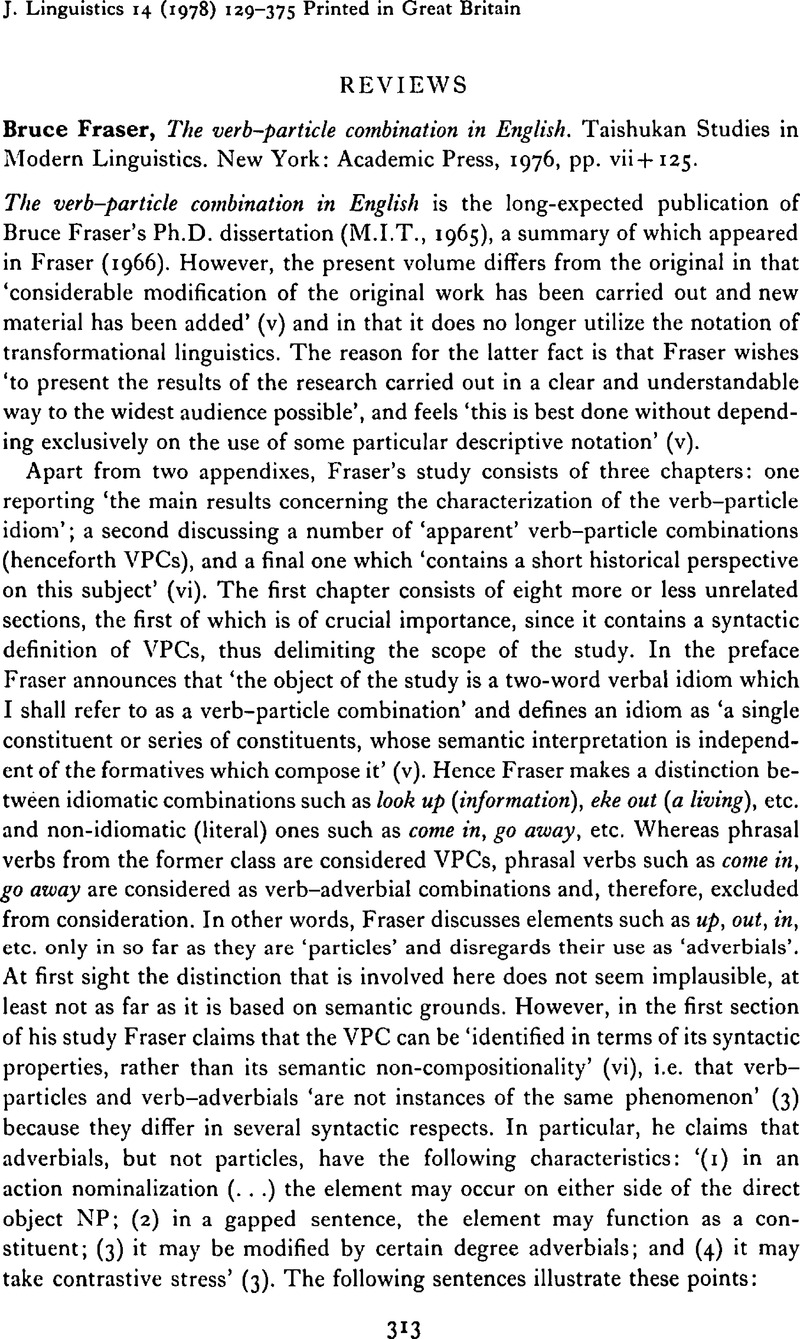No CrossRef data available.
Article contents
Bruce Fraser, The verb–particle combination in English. Taishukan Studies in Modern Linguistics. New York: Academic Press, 1976, pp. vii + 125.
Published online by Cambridge University Press: 28 November 2008
Abstract
An abstract is not available for this content so a preview has been provided. Please use the Get access link above for information on how to access this content.

- Type
- Reviews
- Information
- Copyright
- Copyright © Cambridge University Press 1978
References
REFERENCES
Bolinger, D. (1971). The phrasal verb in English. Cambridge, Mass.: Harvard University Press.Google Scholar
Chomsky, N. (1970). Remarks on nominalization. In Jacobs, R. A. & Rosenbaum, P. S. (eds) Readings in English Transformational Grammar. Boston: Ginn Blaisdell, 184–221.Google Scholar
Declerck, R. (1976a) Literal phrasal verbs and prepositions in English. A study in generative semantics. Unpublished Ph.D. dissertation, Leuven.Google Scholar
Declerck, R. (1976b) A proposal concerning the underlying structure of literal phrasal verbs. Preprint nr. 2 Faculteit Wijsbegeerte en Letteren K. U. Leuven Campus Kortrijk.Google Scholar
Declerck, R. (forthcoming). Some arguments in favor of a generative semantics analysis of sentences with an adverbial particle or a prepositional phrase of goal. To appear in Orbis.Google Scholar
Dietrich, G. (1960). Adverb oder Präposition? Zu einem klärungsbedürftigen Kapitel der englischen Grammatik. Halle: Niemeyer.Google Scholar
Fairclough, N. L. (1965). Some English phrasal types: studies in the collocation of lexical items with prepositions and adverbs in a corpus of spoken and written present-day English. MA. thesis, University College London.Google Scholar
Fraser, B. (1966). Some remarks on the verb–particle construction in English. In Dinneen, F. (ed.) 19th monograph on languages and linguistics. Washington D.C. 45–61.Google Scholar
Fraser, B. (1970). Some remarks on the action nominalization in English. In Jacobs, R. A. & Rosenbaum, P. S. (eds) Readings in English Transformational Grammar. Boston: Ginn Blaisdell. 83–98.Google Scholar
Konishi, T. (1958). The growth of the verb–adverb combination in English: a brief sketch. In Araki, , Kazua, et al. (eds) Studies in English grammar and linguistics: a miscellany in honour of Takanobu Otsuka. Tokyo: Kenkyusha. 1958.Google Scholar
Lindelöf, U. (1941). English verb–adverb compounds converted into nouns. Societas Scientiarum Fennica, CHL 9. 5. 1–41.Google Scholar
Marchand, H. (1956). Compounds with locative particles as first elements in present-day English. Word 12. 395–398.CrossRefGoogle Scholar
Marchand, H. (1957). Compound and pseudo-compound verbs in present-day English. AS 32. 83–94.Google Scholar
Mitchell, T. F. (1958). Syntagmatic relations in linguistic analysis. TPhS, 1958. 101–118.CrossRefGoogle Scholar
Taha, , Abdul, Karim. (1960). The structure of two-word verbs in English. LL, 10. 115–122.Google Scholar
van Dongen, W. A. Sr (1919). ‘He put on his hat’ and ‘he put his hat on’. Nph 4. 322–353.Google Scholar




